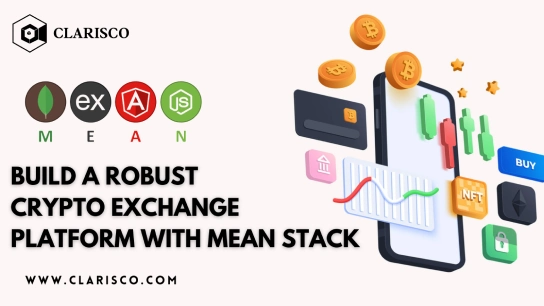
























































































































































































Clarisco requests your action to continue
The above mentioned products are used only for clear understanding. We don't have control of the brand and are not doing direct & indirect partnerships with them. We are also not doing promoting activities for them.
According to Tyrone Ross, a financial advisor and CEO of Onramp Invest, there is no one crypto exchange that is ideal for every user. Instead, he suggests evaluating your personal crypto interests and finding an exchange that corresponds with your aims. Cryptocurrency exchanges have garnered immense traction in the past few years, especially due to the ever-increasing demand for cryptocurrencies and big giants like Microsoft and Google investing in them. It is a known factor that “with fame comes responsibility”. Thus, one must build a cryptocurrency exchange that is bullet-proof against any kind of threats that might arise. This is where “the MEAN Stack” comes in.
MEAN is an acronym that stands for MongoDB, Express.js, AngularJS, and Node.js. MEAN is a comprehensive JavaScript stack that is mostly used for cloud-ready apps. MEAN Stack is a free and open-source stack that provides an effective way to create swift prototypes for web-based applications. Understanding why you should use it, identifying examples of when you might use it, and delving further into the different components will all help you get the most out of MEAN for cryptocurrency exchange development.
The phrase "stack" refers to a collection of programming languages, software tools, and technologies. A stack is often divided into two types: application stacks and technology stacks. The application stack would cover basic functions like email, databases, and word processing. The technology stack, on the other hand, is a list of the technical services required to operate an application. The most well-known examples of a technological stack are MERN Stack and MEAN Stack. Let's take a closer look at how MEAN Stack differs from MERN Stack.
Both MEAN and MERN differ notably in their overall architectural component alignment: It is Angular.js in MEAN and React.js in MERN. Despite the fact that both Angular.js and React.js are used to organize UI layers and have extensive documentation and sample code, they induce a little variation between MEAN and MERN. While MEAN is backed by Google Inc., MERN is backed by Facebook Inc. MEAN has a learning curve, however, MERN is fairly basic and straightforward. MEAN Stack is chosen for enterprise-level architecture, whereas MERN is preferred for the rapid development of smaller apps. And the list goes on. In the end, it all depends on your specific requirements!
Analyze project requirements to ensure the stack's effectiveness. Introduce Agile development methodologies to experience a market driven by customers.To preserve flexibility, keep the distinctions between database design and software solutions in mind. Identify multiple cost-effective approaches for the overall development process.
The term "MEAN" was coined in 2013 by Valeri Karpov, a MongoDB developer, in a blog post that outlined the benefits of using a single language throughout a technology stack.
Whilst MEAN Stack isn't ideal for every application, it does shine in many. Because of its scalability and ability to manage concurrent users, it is an excellent choice for designing cloud-native apps. Because MEAN Stack is built on JavaScript, it allows android app development companies to design solutions that work seamlessly between server-side and client-side execution settings. And the MEAN Stack is quite popular because of its incredible versatility in building strong, fast, and scalable web and mobile apps.
Some surprising real-time use cases of the MEAN Stack include - Youtube, Facebook, Instagram, Tumblr, Netflix, and PayTM.
MongoDB is a NoSQL database that is open source and intended for cloud applications. It employs an object-oriented organization rather than a relational model. MongoDB stores the application's data when it comes to the MEAN Stack. Because both the application and the database are written in JavaScript, the object does not need to be translated when it moves from the application to the database and back. Without skipping a beat, the application can push and pull objects between the back end and the database. MongoDB is praised for its storage and performance scalability. You can add fields to the database without having to refresh the entire table, and MongoDB is widely renowned for its capacity to manage enormous volumes of data while maintaining data access. With a few clicks, you can augment the resources available to your database, making it ideal for applications that see spikes in activity.
Express, the MEAN Stack's backend, manages all interactions between the front end and the database, guaranteeing seamless data transmission to the end user. It's intended to be used with Node.js, thus it maintains the stack's continuous use of JavaScript. Express is a web application framework for Node.js and strikes a balance between simplicity of use and a comprehensive feature set. Express is meant to handle tasks swiftly without cluttering your application. But don't mix up minimalism and featurelessness. To enhance your development, Express provides outstanding error handling and templating capability.
AngularJS, Google's JavaScript frontend framework, isn't the only one in use, but it's the most popular. It is the de facto standard for front-end JavaScript development. AngularJS is employed for building a web application in JavaScript. The MEAN Stack contains AngularJS to assist developers in designing the application's user interface. Because the backend, frontend, and database are all developed with JavaScript, information flows smoothly across all areas of your app. AngularJS did not rise to prominence as the most popular JavaScript frontend framework by chance. Its flexibility to develop for desktop and mobile use at the same time, as well as its well-tuned performance and user-friendly templates, make it the ideal front-end for building cloud-native apps.
Node.js is a JavaScript framework that employs asynchronous events to process numerous connections at the same time. It's an excellent framework for a cloud-based application since it can easily scale requests on demand. Most well-known web presences are likely to use Node.js. The MEAN Stack is based on Node.js. Express is designed to function on top of Node.js, and AngularJS smoothly links to Node.js for rapid data serving. Node.js includes a built-in web server, making it easy to deploy your MongoDB database and application to the cloud.
Node.js's strongest point is its scalability. Cloud applications perform best when they can adapt promptly to increases in usage. What good is practically infinite computing power if it can only be accessed after your users have logged out? You can serve additional people by growing your resources as needed, and the framework's single-thread architecture allows the application to successfully deliver a fluid user experience across many connections. Node.js can accommodate up to a million concurrent connections. How cool is that?
STEP 1: As the client-side language, AngularJS is the fundamental one to work on the client's request.
STEP 2: Because JavaScript is the server-side language, the client request is subsequently sent to Node.js.
STEP 3: Express then enters the process by generating a database request.
STEP 4: MongoDB receives the data and returns it to Express.
STEP 5: Node.js delivers the data to AngularJS to display the results, and then the data is retrieved from Express.
MEAN Stack's biggest feature is its independence, which is useful for the development and deployment of complex projects such as cryptocurrency exchange. The deployment does not need any special configuration. This capability provides a plethora of possibilities and solves a variety of obstacles that one might experience in other full-stack frameworks.
MEAN Stack, being a collection of highly adaptable components, simplifies both the development process and the associated complexities that might come with it. Because MongoDB is open source, it is easy to make modifications while developing itself. This comes in handy while developing sophisticated apps such as cryptocurrency exchanges. Additionally, while adding a file to the database, there is no need to refresh the complete table. MongoDB can manage massive amounts of data while facilitating the expansion of database resources.
Say what? Yep, you heard that right! The open-source feature of MEAN Stack, which is often used by open-sourced freely accessible technologies, facilitates access to the codes of each participating component, allowing developers to modify and update them as required. It generates countless remedies as well as novel ideas to ultimately accomplish them. The MEAN Stack helps in developing feature-rich, high-end solutions like crypto exchange while saving enormous development time.
MEAN Stack leverages JAVA for everything, removing the developer's difficulty in connecting client and server. Because both apps and databases utilize JAVA Script, this eliminates the need for translation. This allows for frictionless object transfer between the database and the back end. MEAN Stack facilitates the transition between client and server by including Node.js as a web server.
MEAN Stack is an end-to-end package that includes efficiency, speed, and scalability, all thanks to Node.js, which is a key component of it. Node.js makes runtime quick and scalable by not utilizing the blocking structure. Everything is handled automatically by Node.js. MEAN Stack clients do not need to direct a query creation request. MEAN Stack saves a significant amount of money by using JavaScript for all languages.
MEAN Stack applications are adaptable, flexible, and customizable, making them ideal for cryptocurrency exchange development. The stack comes with its own web server, making it simple to install, and the database can be expanded on demand to support transient consumption surges (which is quite common for crypto exchange platforms).
A MEAN application enters the world ready to take advantage of the hefty cost reductions and performance benefits. The MEAN Stack is a fantastic solution for cryptocurrency exchange development because of its flexibility, uniform language, and scalability. It features a great degree of adaptability to help you manage user-generated data. If you are on the lookout to build a revolutionary cryptocurrency exchange with the MEAN Stack, our team of expert MEAN developers can provide you with the required assistance and ultimately a killer product! Get in touch with us today!
If you want to start your own crypto exchange platform with MEAN Stack Development? then feel free to consult with our experts by filling in the below form
Our trustworthy and happy Clients

200+

served Clients with a happy smile
Awards & Recognition
We are extremely pleased that reputable publications around the world recognised our superior work.




We'd Love To Hear From You!
Know your requirement, our technical expert will schedule a call and discuss your idea in detail. All information will be kept confidential.

Plot No. 29, 30, Iswarya Nagar,
Madakkulam, Tamil Nadu 625003, India
Business@clarisco.com +91 9442430551Monday-Saturday: 10am - 7pm
Sunday: Closed
